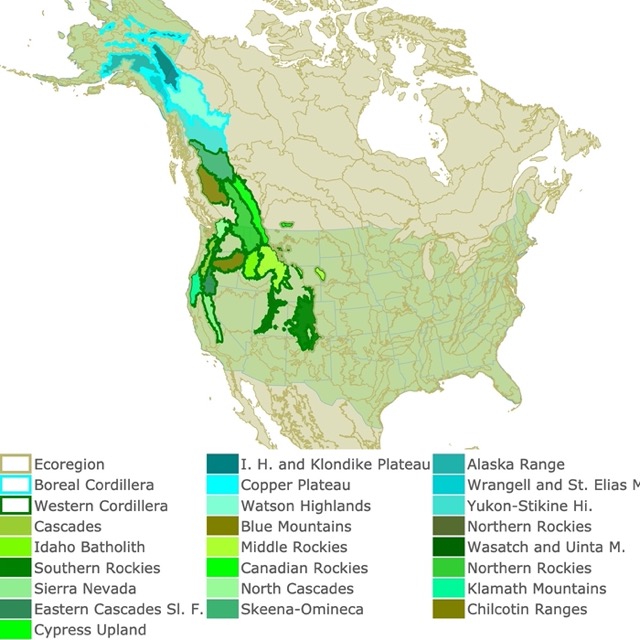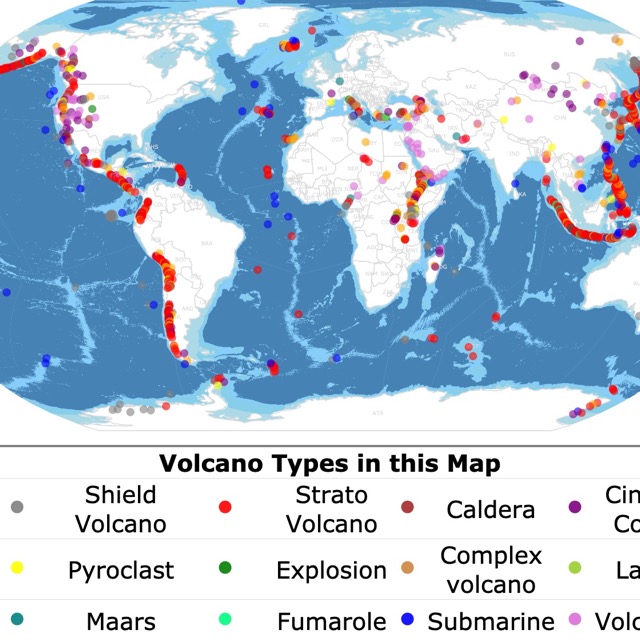Arctic Permafrost Map
This interactive map shows the Permafrost and Ground Ice in the Arctic. Bluer shades have a higher permafrost concentration. Fuchsia shades have lower Permafrost concentration. To find the classification check the key. For precise information, hover over the map. To learn more about this map, scroll down.
| Permafrost Extent | Lowlands, highlands, and intern montante depressions with thick overburden cover | Mountains, Highlands, Ridges and Plateaus with thin overburden cover | |||
| Percent of Area | High <20% | Medium 10-20% | Low 0-10% | High to medium >10% | Low 0-10% |
| Continuous (90-100%) | |||||
| Discontinuous (50-90%) | |||||
| Sporadic (10-50%) | |||||
| Isolated Patches (0-10%) | |||||
Permafrost Definition
Permafrost is any type of ground, that remains at, or below 32°F (0°C) for at least 2 years in a row. Permafrost is made of rocks, sand, and soil held together by ice.
Permafrost forms when water trapped in the sediment freeze. If the water that freezes thaws every year it is considered seasonally frozen.
Permafrost can be less than a couple of feet thick to one mile thick.

Most of the permafrost found today was formed during glacial periods and has survived until today. This means some of it was formed during the Holocene 11,700 years ago. It also means that another small portion was formed during the Little Ice Age 400 years ago.
On top of the permafrost is a layer that is not frozen all year long. This surface layer is called Active Layer. The Active Layer thaws in the summer and freezes again in the fall. Depending on where permafrost is found, the Active Layer can be a few inches in cold areas to several meters thick in warmer areas.
The top layer of permafrost is rich in organic matter from dead plants that froze but never decomposed.
A quarter of the land area in the Northern Hemisphere has permafrost underneath. This is about 9 million sq miles (23 million km²), Source: IPA.arcticportal.org
Where is Permafrost Found?
Permafrost is primarily found in higher latitudes near the North and South Poles. It is widespread in Siberia, Canada, and Greenland. Close to 85% of Alaska is on top of Permafrost.
It is also found in high mountains like the Rocky Mountains, and the Himalayas. In the Southern Hemisphere is found on top of the Andes, New Zeland Southern Alps, and below Antarctica.
A quarter of the land area in the Northern Hemisphere has permafrost underneath. This is about (23 million km²), Source: IPA.arcticportal.org
A layer of soil that freezes for more than 15 days a year is called "seasonally frozen ground." A layer of soil that freezes between 1 and 15 days a year is called "intermittently frozen ground".
The Biome where permafrost is found is the Tundra. In the Tundra, the top layer of soil thaws a few inches; providing a site for plant and root growth.
There is also permafrost under the sea. It occurs at temperatures close to 32°F (0°C) in large areas of the Arctic continental shelf.
There are areas in Alaska where permafrost is present on the side of mountains that face north but it is not present on the sides that face south. This is because these sides get more sun throughout the year. This is a case of Discontinuous Permafrost.
Permafrost Types
Lowland permafrost is classified in:
- Continuous Permafrost: Underlying 90 to 100% of the landscape.
- Discontinuous Permafrost: Underlying 50 to 90% of the landscape. This is permafrost broken up into separate areas.
- Sporadic Permafrost: Underlying 10 to 50% of the landscape.
- Isolated Permafrost: Underlying 0 to 10% of the landscape.
Melting Permafrost
Due to Climate Change and warming temperatures twice faster in the Arctic, Permafrost is thawing rapidly. Scientists calculate that there is 10% less permafrost now than in the 1900s.
It is believed that for every additional 1.8°F (1°C) of temperatures warming, an additional 1.5 million square miles of permafrost would eventually thaw. Source: NRDC.org
Consequences of Melting Permafrost
Many towns and villages in the northern hemisphere are built on permafrost. When permafrost thaws and collapses it can destroy homes and roads.
Permafrost has frozen organic matter. When this organic material decomposes, large amounts of carbon dioxide are released into the atmosphere. This results in more greenhouse gases contributing to Climate Change.
Many of the microbes on frozen permafrost have been preserved for thousands of years. We don't know what is going to be their effect in living organisms including human beings today.
In 2016 there was an anthrax outbreak in Siberia. This outbreak was attributed to anthrax spores exposed to the air after permafrost in the area thawed. The question remains about how great a risk these ancient microbes pose.
Thawing permafrost also affects natural landscapes. It creates Thermokarsts, which are areas with sagging ground and shallow ponds. This makes soil more prone to erosion, and landslides. This erosion may also introduce new sediment to waterways and degrade water quality. Source: Natural Resources Defense Council
Finally, thawing permafrost may also result in drier ground which in turn may result in landscapes more susceptible to wildfires.
How is Permafrost Studied?
Scientists go out in the field to gather information about ground temperature, moisture, and depth. Scientists also monitor the thickens of the active layer over permafrost.
To get all the data they need, scientists drill holes on the ground. But friction creates heat. To prevent this heat from reaching the sample researchers use protected pipes and blow cold air while drilling the holes!
Different monitoring sites have been established throughout the Arctic. Some of them have been collecting data since the 1840s. The long term data helps researchers understand the past and model the future of permafrost. Source National Snow & Ice Data Center.
Permafrost Map Resources
This map displays different types of permafrost and ground ice in the Northern Hemisphere between 20°N to 90°N.
The permafrost shapefiles where downloaded from the National Snow & Ice Data Center.
The country shapefiles where downloaded from Natural Earth.
Inspiration for Permafrost Map
I had the opportunity to visit a friend in Alaska. We drove from Anchorage to Fairbanks. In that trip I had the opportunity to learn about permafrost and how it present in one side of the mountains but not the other.
She also showed me some Mammoth remains that had been found on caves and melting permafrost. I was fascinated because it sounded like a time machine or time capsule. It was quite common to get Mammoth ivory in different shops around Alaska!
Many years later I found myself in the Norwegian Arctic at the Arctic University of Tromsø. I asked some of the local students about Permafrost in the area and they seemed baffled. I later assumed there was none because of the Gulf stream.
I recently found the strange reason why further north areas had none. In humid boreal forests, such as in Northern Scandinavia and the North-Eastern part of European Russia west of the Urals, snow acts as an insulating blanket. There is no Permafrost there.
This map will be updated with improved and recent information! To receive updates on this and more nature maps join my email list!!!!!!!
Made by Luz K. Molina with D3.js.





